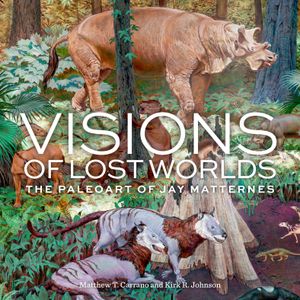Discover Lost Worlds with Stunning Paleo Art
Step back in time through the work of renowned paleoartist Jay Matternes
:focal(639x383:640x384)/https://tf-cmsv2-smithsonianmag-media.s3.amazonaws.com/filer_public/b7/ce/b7ce0aaa-a589-4d3a-a4f3-6afeb61b10c0/poebrotherium.jpg)
© Jay Matternes
For nearly 50 years, a visit to the fossil halls of the Smithsonian National Museum of Natural History (NMNH) was not complete without viewing the lost worlds revealed through the artistic work of Jay Matternes. Uniquely among the objects in those halls, the murals and dioramas that he created for the museum conveyed the living, breathing reality of familiar places in distant times. Viewed by tens of millions of people, Matternes’s work has influenced generations of paleontologists and paleoartists. Here, we present a closer look at his incredible work on five pre-historic animals.
1. The Short-Faced Bear
/https://tf-cmsv2-smithsonianmag-media.s3.amazonaws.com/filer_public/75/b7/75b72ed9-341c-44b9-80a1-67030f0830ab/short_faced_bear.jpg)
Matternes invested tremendous attention into the details of each species he reconstructed. He developed the mural’s short-faced bear (Arctodus simus) first as an articulated skeleton (top left), individually drawing and measuring its bones from a specimen in the Field Museum. He then layered on the animal’s deep and superficial musculature (below left) and finally clothed it in finely textured fur (below right). These drawings include corrections that the artist made based on Finnish paleontologist Bjorn Kurtén’s (then lecturing at Harvard) suggestions that the original sketch had an extra lumbar vertebra.
2. Uintatherium
/https://tf-cmsv2-smithsonianmag-media.s3.amazonaws.com/filer_public/fe/c8/fec8bde7-e4fd-4214-9efe-f8e2537d3605/uintatherium_3.jpg)
/https://tf-cmsv2-smithsonianmag-media.s3.amazonaws.com/filer_public/78/23/7823313a-cef0-4ade-843c-d85cb2958f88/uintatherium.jpg)
3. Poebrotherium
/https://tf-cmsv2-smithsonianmag-media.s3.amazonaws.com/filer_public/b7/ce/b7ce0aaa-a589-4d3a-a4f3-6afeb61b10c0/poebrotherium.jpg)
© Jay Matternes
The early camel Poebrotherium was small and graceful, and probably lived much as deer do today, browsing in a variety of environments. The beautiful coloration and evocative behavior envisioned by Matternes make Poebrotherium one of the more striking mammals in the mural they are part of.
4. Slingshot-Nosed Synthetoceras
/https://tf-cmsv2-smithsonianmag-media.s3.amazonaws.com/filer_public/54/a8/54a85f6e-b92f-4048-a7b0-1a32ccf77e99/slingshot-nosed_synthetoceras.jpg)
Synthetoceras is among the most bizarre mammals in this scene. Only males developed these extreme, slingshot-shaped nose horns, which may have been used in competitions for mates. A member of the protoceratids, a now-extinct group of hoofed mammals, it was perhaps most closely related to camels. Matternes based the animal’s varied fur textures on those of the modern pronghorn.
5. Daeodon
/https://tf-cmsv2-smithsonianmag-media.s3.amazonaws.com/filer_public/1b/fa/1bfaf209-9a82-4b99-b9bd-95c793e3ad40/daeodon.jpg)
© Jay Matternes
/https://tf-cmsv2-smithsonianmag-media.s3.amazonaws.com/filer_public/61/0c/610c86ee-dc45-4e21-9c3d-4938cac8e859/daeodon_2.jpg)
© Jay Matternes
Once known by the evocative name Dinohyus (“fearfully great hog”), the entelodont Daeodon (“dreadful tooth”) must have been a terrifying presence in these grasslands. Omnivorous animals with enormous heads, entelodonts resembled overdeveloped boars with gigantic canines. Matternes observed that “teeth like that are really the anatomy of aggression” and portrayed this animal as the king of the beasts—but he gave no hints as to his assessment of its dietary preferences.
Matternes’s murals and dioramas have thrilled and inspired generations of visitors since their installation half a century ago. But the details of his process, and the stages of development, have been largely hidden from view. By presenting them here, we hope to encourage new appreciation of the depth and beauty of Matternes’s work. They remain endlessly rewarding to study, and new details appear upon each viewing.
Visions of Lost Worlds is available from Smithsonian Books. Visit Smithsonian Books’ website to learn more about its publications and a full list of titles.
Excerpt from Visions of Lost Worlds © 2019 by Smithsonian Institution Illustrations © 2019 by Jay Matternes

